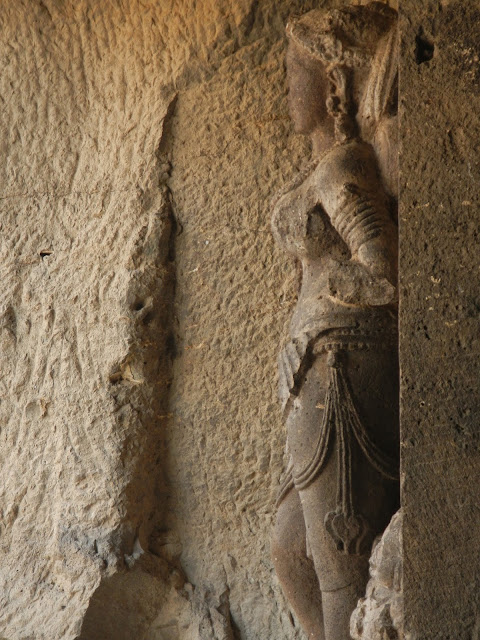While I avoid tourist areas and
particularly avoid non-Indian tourist areas like the Taj Mahal in Agra or the
world famous ghats along the Ganges in Varanasi, there is one that happens to
be on my usual route north to south and makes a good place to stop, so I went
to the now recognized World Heritage site called Ellora, about 40km north west
from Aurangabad in Maharashtra state. So I spent the night in Ellora and then
had to get some work done in the morning so it was late morning before I got to
the caves and it was already starting to get busy so I headed straight way to
the farthest cave to get some caves to myself.
For some background, some
millions of years ago there was a major volcanic eruption and what now is
Ellora was a tongue of lava flowing into a valley. Around the 6th
century some monks began carving caves out of the ‘soft’ lava stone for temples
and for meditation spots during the monsoon. Over the next 800 years, what
began as a small effort turned into a massive construction project of
unbelievable proportions. By 1400 or so the last one of the current 33 temples
or so had been completed.
So when I entered the first one,
one of the earlier, cruder works it was breathtaking, literally I stopped
breathing in wonderment at the level of effort, grandeur and size of it.
Over the next few hours I walked
about from complex to complex in awe of the master builders to had construct
such marvels.
The largest complex is not
actually a cave at all but instead carved straight down some 220 feet into the
stone and covers a number of acres. Just for this one complex it took some
7,000 people, 200 years to carve out of the solid rock. So maybe 15 generations
of architects and because everything is carved from a single piece of rock
there can not be any mistakes and the entire design has to be there from the
very first.
The carving is intricate and what
we see today is only the crude underlayment. When they were completed, they had
a fine layer of plaster that was then intricately painted to add to and
accentuate the carving. Only a very little of the original plastering remains.
This is of a small bit of a remaining ceiling mural
About 30 miles to the north of Ellora there is a smaller complex within the same formation call Ajanta.
If this were somewhere else than India, like the middle east, Europe or China it would be world famous but since it is in India no one has heard of it.
This is of a small bit of a remaining ceiling mural
About 30 miles to the north of Ellora there is a smaller complex within the same formation call Ajanta.
If this were somewhere else than India, like the middle east, Europe or China it would be world famous but since it is in India no one has heard of it.
















No comments:
Post a Comment